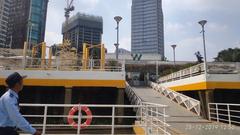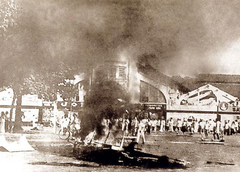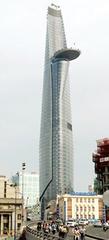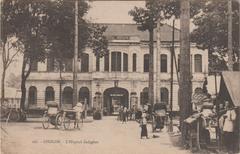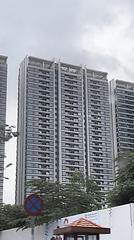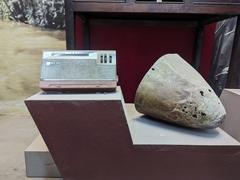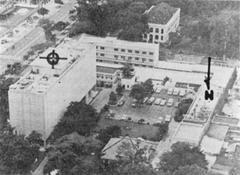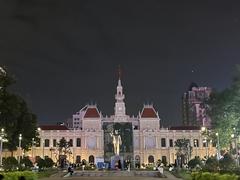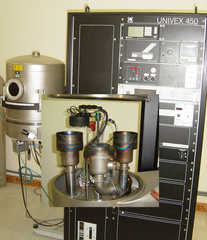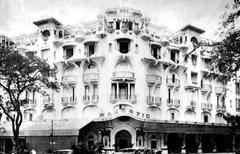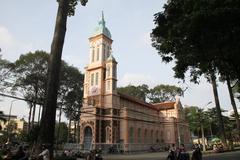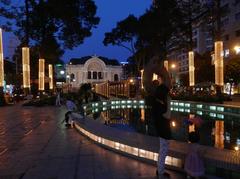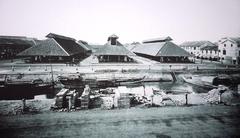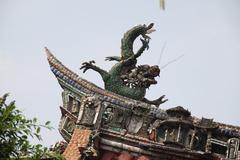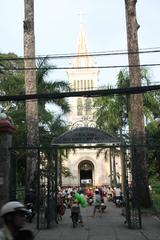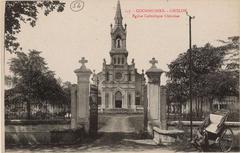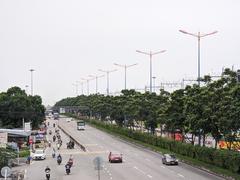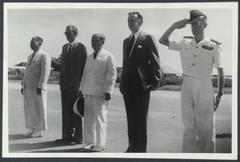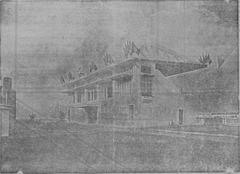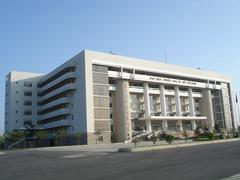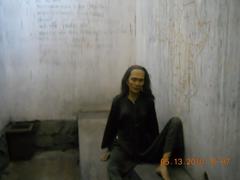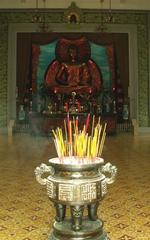
Grand Hotel Saigon Visiting Hours, Tickets, and Travel Guide – Ho Chi Minh City Historical Sites
Date: 04/07/2025
Introduction
Nestled in the heart of Ho Chi Minh City, the Grand Hotel Saigon is a living testament to French colonial grandeur and Vietnam’s dynamic history. Since its establishment in 1930, this iconic landmark has evolved from a social hub for French and Vietnamese elites to a five-star hotel that blends old-world charm with modern sophistication. With its meticulously preserved colonial features—including arched windows, wrought-iron balconies, and antique interiors—the Grand Hotel Saigon offers a unique window into Saigon’s rich past and vibrant present. Ideally located on Dong Khoi Street, the hotel is steps away from cultural treasures such as the Saigon Opera House and Notre Dame Cathedral, making it an essential stop for history enthusiasts, architecture lovers, and travelers seeking an authentic Saigon experience (Grand Hotel Saigon Official, Historic Hotels Then and Now, Vietnam Travel).
Table of Contents
- Origins and Early Development (1920s–1930s)
- Ownership Transitions and Name Changes (1930s–1970s)
- Architectural Significance and Preservation
- Notable Events and Distinguished Guests
- The Grand Hotel During and After the Vietnam War
- Restoration and Modern Era (1990s–Present)
- Cultural Significance
- Practical Visitor Information (Visiting Hours, Tickets, Tours, Travel Tips)
- Facilities and Services
- Nearby Historical Sites and Attractions
- Frequently Asked Questions (FAQ)
- Conclusion and Call to Action
- References
Origins and Early Development (1920s–1930s)
The Grand Hotel Saigon traces its roots back to October 24, 1928, when Henry Chavigny de Lachevrotière—a French politician and journalist—acquired a license to open a beverage shop at the corner of Catinat and Vannier streets (now Dong Khoi and Ngo Duc Ke) (historichotelsthenandnow.com; hotelgrandsaigon.com). This small establishment quickly became a gathering spot for the city’s French and Vietnamese elite. In 1929, construction commenced on a larger hotel at 8 Rue Catinat (now 8 Dong Khoi Street), featuring 68 rooms and classic French architectural elements. The Grand Hotel Saigon officially opened in 1930, with its architectural style reflecting the elegance of the period (vietnam.travel).
Ownership Transitions and Name Changes (1930s–1970s)
The hotel’s early decades saw significant changes. In 1932, Patrice Luciani purchased the property and, in 1937, renamed it the “Saigon Palace” after merging it with the original Saigon Palace Hotel (famoushotels.org). Under Luciani, the hotel flourished as a center for social events, concerts, and gatherings. In 1939, ownership passed to Antoine Giorgetti, and the hotel remained under French management through the political shifts of the mid-20th century. In 1958, the hotel adopted the Vietnamese name “Saigon Dai Lu Quan,” signifying a new era that lasted until 1975.
Architectural Significance and Preservation
The Grand Hotel Saigon exemplifies French colonial architecture in Vietnam. Its original features—arched windows, wrought-iron balconies, stained glass, high ceilings, and classic facades—have been carefully preserved (vietnam.travel). The Ancient Wing in particular offers guests a step back in time, with antique elevators, wooden parquet floors, and beaded chandeliers. Major restoration between 1995 and 1998 modernized the facilities while safeguarding historic elements (historichotelsthenandnow.com). Today, guests can enjoy both the original colonial ambiance and the comforts of the Luxury Wing.
Notable Events and Distinguished Guests
Throughout its history, the Grand Hotel Saigon has hosted prominent figures, including writers André Malraux and Graham Greene and Nobel laureate Rabindranath Tagore (authentiktravel.com). The hotel was a lively center for journalists, diplomats, and business leaders, especially during times of political change. Its grand ballroom, terrace café, and rooftop lounge have witnessed countless social gatherings and official receptions, cementing the hotel’s reputation as a symbol of Saigon’s cosmopolitan spirit.
The Grand Hotel During and After the Vietnam War
During the Vietnam War, the hotel—then Saigon Dai Lu Quan—remained a gathering place for correspondents, diplomats, and local elites. After reunification in 1975, it was nationalized and renamed the Dong Khoi Hotel (hotelgrandsaigon.com). By 1994, the property was under the Saigontourist Holding Company, setting the stage for its historic restoration and renewed international status (historichotelsthenandnow.com).
Restoration and Modern Era (1990s–Present)
Between 1995 and 1998, a comprehensive renovation expanded the hotel’s capacity and modernized its amenities (hotelgrandsaigon.com). Recognized as a four-star property in 2003 and upgraded to five-star status in 2011, the Grand Hotel Saigon now boasts 250 rooms and suites, a rooftop lounge, swimming pool, spa, and multiple dining venues (famoushotels.org). It has also received ISO 14001 certification for its commitment to environmental sustainability.
Cultural Significance
Social and Cultural Exchange
Since its opening, the Grand Hotel Saigon has been a hub for cultural events, artistic gatherings, and diplomatic receptions, fostering the cosmopolitan identity of Ho Chi Minh City. Today, it continues to host art exhibitions, live music, and culinary events that celebrate both Vietnamese and international traditions (Delightful Travel Notes).
Saigonese Hospitality
The hotel exemplifies the warmth and openness of Saigonese culture, with staff known for their friendliness and attention to detail (IDC Travel). Its restaurants showcase Saigon’s diverse culinary scene, offering both local and international flavors.
Engagement with Local Traditions
During festivals such as Tet and the Mid-Autumn Festival, the hotel is adorned with traditional decorations and hosts special events, allowing guests to immerse themselves in Vietnamese customs (IDC Travel). Gift shops and public spaces feature local arts and crafts, supporting cultural preservation.
Practical Visitor Information
Visiting Hours and Admission
- Public Areas: Open daily from 6:00 AM to 11:00 PM.
- Rooftop Bar: Typically open from 5:00 PM to midnight.
- Restaurants: Breakfast service usually starts at 6:30 AM; other hours vary by venue.
- Lobby: Open 24/7 for guests and visitors (Grand Hotel Saigon Official).
Admission to public areas is free. Some cultural events or guided tours may require advance booking.
Tickets and Booking
- No general entry fee for public spaces.
- Guided tours: Available occasionally; book in advance via the hotel’s official website or through the concierge.
- Special events: Check the official website for the latest calendar.
Accessibility
- Facilities for disabled guests: Ramps, elevators, and accessible rooms are available.
- Contact the hotel prior to arrival for specific requirements.
Getting There
- Address: 8 Dong Khoi Street, District 1, Ho Chi Minh City
- From Airport: 30–45 minutes by taxi or ride-hailing app (Mai Linh, Vinasun, Grab). Airport transfer service available (Trip.com).
- Walking: Major historical sites are within 5–20 minutes on foot (Local Vietnam).
Facilities and Services
- Leisure: Outdoor pool, spa, fitness center, sun deck
- Dining: Buffet breakfast, on-site Asian/international restaurants, rooftop and lobby bars
- Business: Business center, meeting rooms, conference and banquet facilities
- Family: Child-friendly amenities, babysitting services
- Accessibility: Accessible rooms and facilities
- Other: 24-hour room service, concierge, currency exchange, ATM, laundry, luggage storage, guest parking
Nearby Historical Sites and Attractions
- Saigon Opera House: 5-minute walk
- Nguyen Hue Walking Street: 6-minute walk
- Bitexco Financial Tower: 10-minute walk
- Saigon Central Post Office & Notre Dame Cathedral: 15-minute walk
- Ben Thanh Market: 20-minute walk or short taxi ride (Vietnam Travel)
Travel Tips
- Best time to visit: December to April (dry season)
- Currency: Vietnamese Dong (VND); ATMs and exchange available nearby
- Getting around: Walking, taxis, ride-hailing apps; car/motorbike rental with driver only
- Language: Vietnamese (English widely spoken in tourist areas)
- Safety: Keep valuables secure, be cautious crossing streets, dress modestly at religious sites
Frequently Asked Questions (FAQ)
Q: What are the Grand Hotel Saigon’s visiting hours?
A: Public areas are open from 6:00 AM to 11:00 PM; lobby is open 24/7.
Q: Do I need a ticket to visit?
A: No, access to public spaces is free. Special events or tours may require reservations.
Q: Is the hotel accessible for people with disabilities?
A: Yes, accessible rooms and facilities are available; contact the hotel in advance.
Q: Are guided tours available?
A: Yes, occasionally. Inquire at the concierge or check the official website.
Q: Are pets allowed?
A: No, pets are not permitted.
Conclusion and Call to Action
The Grand Hotel Saigon is an unrivaled destination for immersing yourself in Ho Chi Minh City’s architectural heritage and cosmopolitan culture. Whether admiring its colonial elegance, savoring rooftop views, or exploring nearby historical landmarks, you’ll find the hotel a perfect gateway to the city’s past and present. Plan your visit today and enhance your experience by downloading the Audiala app for exclusive guides, insider tips, and the latest event updates. Follow us on social media and check our related posts for more travel inspiration.
References
- Grand Hotel Saigon Official
- Historic Hotels Then and Now
- Vietnam Travel
- Famous Hotels
- IDC Travel
- Delightful Travel Notes
- Local Vietnam
- Trip.com
- Authentik Travel



